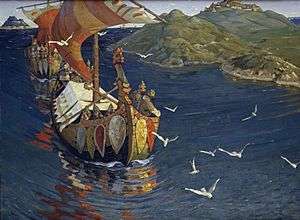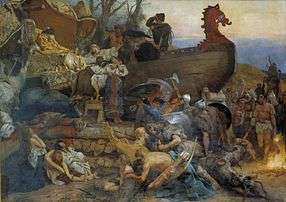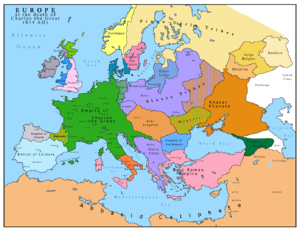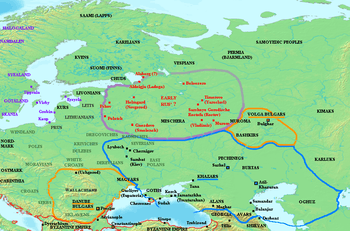Rus' people

The Rus' (Slavic: Русь; Greek: Ῥῶς) were an early medieval group of people who gave their name to the lands of Russia, Ruthenia, and Belarus. According to both contemporary Byzantine and Islamic sources and the Primary Chronicle of Rus', compiled in about 1113 AD, the Rus were Norsemen who had relocated "from over sea", first to northeastern Europe, creating an early polity that finally came under the leadership of Rurik.[1][2]
Later, Rurik's relative Oleg captured Kiev, founding Rus', academically known as Kievan Rus'.[3][4] The descendants of Rurik were the ruling dynasty of Rus' (after 862), and of principalities created in the area formerly occupied by Kievan Rus', Galicia-Volhynia Principality (after 1199), Chernigov, Novgorod Republic, Kingdom of Rus (1253–1349), Vladimir-Suzdal, Grand Duchy of Moscow, and the founders of the Tsardom of Russia.[5]
Etymology
According to the most prevalent theory, the name Rus', like the Finnish name for Sweden (Ruotsi), is derived from an Old Norse term for "the men who row" (rods-) as rowing was the main method of navigating the rivers of Eastern Europe, and that it could be linked to the Swedish coastal area of Roslagen (Rus-law) or Roden, as it was known in earlier times.[6][7] The name Rus' would then have the same origin as the Finnish and Estonian names for Sweden: Ruotsi and Rootsi.[8]
Key sources
Slavic sources
According to the earliest East Slavic record, the Primary Chronicle, the Rus' were a group of Varangians who lived, along with other groups like Swedes and Gutes, on the other side of the Baltic Sea, in Scandinavia and as far as the land of the English and the French.[7] The Varangians were first expelled, then invited to rule the warring Slavic and Finnic tribes of Novgorod:
The four tribes who had been forced to pay tribute to the Varangians—Chuds, Slavs, Merians, and Krivichs—drove the Varangians back beyond the sea, refused to pay them further tribute, and set out to govern themselves. But there was no law among them, and tribe rose against tribe. Discord thus ensued among them, and they began to war one against the other. They said to themselves, "Let us seek a prince who may rule over us, and judge us according to custom". Thus they went overseas to the Varangians, to the Rus. These particular Varangians were known as Rus, just as some are called Swedes, and others Normans and Angles, and still others Gutes, for they were thus named. The Chuds, the Slavs, the Krivichs and the Veps then said to the Rus, "Our land is great and rich, but there is no order in it. Come reign as princes, rule over us". Three brothers, with their kinfolk, were selected. They brought with them all the Rus and migrated.— The Primary Chronicle[9]
Later, the Primary Chronicle tells us, they conquered Kiev and created the state of Kievan Rus' (which, as most historians agree, was preceded by the Rus' Khaganate). The territory they conquered was named after them as were, eventually, the local people (see Etymology of Rus and derivatives for further details).
Islamic sources

Henryk Siemiradzki (1883)
Ibn Haukal and other early Islamic sources, as well as Muhammad al-Idrisi, who would follow them later, distinguish three groups of the Rus: Kuyavia, Slavia, and Arcania. Mainstream Russian-Soviet historiography (as represented by Boris Rybakov), tentatively identified these names with the "tribal centres" at Kiev, Novgorod and Tmutarakan.
The Muslim diplomat and traveller Ahmad ibn Fadlan, who visited Volga Bulgaria in 922, described the Rus' (Rusiyyah) in terms said to suggest Norsemen:
I have seen the Rus as they came on their merchant journeys and encamped by the Itil. I have never seen more perfect physical specimens, tall as date palms, blond and ruddy; they wear neither tunics nor caftans, but the men wear a garment which covers one side of the body and leaves a hand free. Each man has an axe, a sword, and a knife, and keeps each by him at all times. The swords are broad and grooved, of Frankish sort. Each woman wears on either breast a box of iron, silver, copper, or gold; the value of the box indicates the wealth of the husband. Each box has a ring from which depends a knife. The women wear neck-rings of gold and silver. Their most prized ornaments are green glass beads. They string them as necklaces for their women.— Gwyn Jones, A History of the Vikings[10]
Apart from Ibn Fadlan's account, Normanist theory draws heavily on the evidence of the Persian traveler Ibn Rustah who, it is postulated, visited Novgorod (or Tmutarakan, according to George Vernadsky) and described how the Rus' exploited the Slavs.
As for the Rus, they live on an island ... that takes three days to walk round and is covered with thick undergrowth and forests; it is most unhealthy. ... They harry the Slavs, using ships to reach them; they carry them off as slaves and…sell them. They have no fields but simply live on what they get from the Slav's lands. ... When a son is born, the father will go up to the newborn baby, sword in hand; throwing it down, he says, "I shall not leave you with any property: You have only what you can provide with this weapon."
In his 891 Treatise on the Regions, the Muslim geographer Ya'qubi mentions the 844 sack of Seville in Al-Andalus by Vikings, noting that the city was penetrated by "al-Majus [Vikings] who are called al-Rus, who took captives slaughtered, burnt and plundered."[12]
Byzantine sources
- Further information: Rus'–Byzantine War and Rus'–Byzantine Treaty
When the Varangians first appeared in Constantinople (the Paphlagonian expedition of the Rus' in the 820s and the Siege of Constantinople in 860), the Byzantines seem to have perceived the Rhos (Greek: Ῥώς) as a different people from the Slavs. At least no source says they are part of the Slavic race. Characteristically, pseudo-Symeon Magister and Theophanes Continuatus refer to the Rhos as Δρομῖται (transliterated as Dromitai), a word related to the Greek word meaning a run, suggesting the mobility of their movement by waterways.[13]
In his treatise De Administrando Imperio, Constantine VII describes the Rhos as the neighbours of Pechenegs who buy from the latter cows, horses, and sheep "because none of these animals may be found in Rhosia". His description represents the Rus' as a warlike northern tribe. Constantine also enumerates the names of the Dnieper cataracts in both Rhos and in Slavic languages. The Rhos names have distinct Germanic etymology:[14]
- Essoupi (Old Norse vesuppi, "do not sleep")
- Oulvorsi (Old Norse holmfors, "island rapid")
- Gelandri (Old Norse gjallandi, "yelling, loudly ringing")
- Aeifor (Old Norse eiforr, "ever fierce")
- Varouforos (Old Norse varufors, "cliff rapid" or barufors, "wave rapid")
- Leanti (Old Norse leandi, "seething", or hlæjandi, "laughing")
- Stroukoun (Old Norse strukum, "rapid current").
The Rus'–Byzantine Treaties give a valuable insight into the names of the Rus'. Of the fourteen Rus' signatories to the Rus'–Byzantine Treaty in 907, all had Norse names.[15] By the Rus'–Byzantine Treaty (945) in 945, some signatories of the Rus' had Slavic names while the vast majority had Norse names.[15]
Western European sources
The first Western European source to mention the Rus' are the Annals of St. Bertin. These relate that Emperor Louis the Pious' court at Ingelheim, in 839, was visited by a delegation from the Byzantine emperor. In this delegation there were two men who called themselves Rhos (Rhos vocari dicebant). Louis enquired about their origins and learnt that they were Swedes. Fearing that they were spies for their brothers, the Danes, he incarcerated them. Subsequently, in the 10th and 11th centuries, Latin sources routinely confused the Rus' with the extinct East Germanic tribe of Rugians. Olga of Kiev, for instance, was designated in one manuscript as a Rugian queen.
Another source comes from Liutprand of Cremona, a 10th-century Lombard bishop who in a report from Constantinople to Holy Roman Emperor Otto I wrote that he had met "the Rus whom we know by the other name of Norsemen.[16][17]
History
Having settled Aldeigja (Ladoga) in the 750s, Scandinavian colonists played an important role in the early ethnogenesis of the Rus' people and in the formation of the Rus' Khaganate. The Varangians (Varyags, in Old East Slavic) are first mentioned by the Primary Chronicle as having exacted tribute from the Slavic and Finnic tribes in 859. It was the time of rapid expansion of the Vikings in Northern Europe; England began to pay Danegeld in 859, and the Curonians of Grobin faced an invasion by the Swedes at about the same date.
Due largely to geographic considerations, it is often argued that most of the Varangians who traveled and settled in the lands of eastern Baltic, modern Russian Federation and lands to the south came from the area of modern Sweden.[18]
The Varangians left a number of rune stones in their native Sweden that tell of their journeys to what is today Russia, Ukraine, Greece, and Belarus. Most of these rune stones can be seen today, and are a telling piece of historical evidence. The Varangian runestones tell of many notable Varangian expeditions, and even account for the fates of individual warriors and travelers.
The Norsemen allegedly had some enduring influence in Rus, as testified by loan words (these ones persist from Glagolitic script at Adriatic prior and out of any norse), such as yabeda "complaining person" (from æmbætti, embætti "office"), skot [19] "cattle" (? from skattr "tax") and knout (from knútr, "a knotty wood"). Moreover, three Nordic names of the first Varangian rulers also became popular among the later Rurikids and then among the East Slavic people in general: Oleg (Helgi), Olga (Helga) and Igor (Ingvar).
Academic study
Normanism
The Western account of the Norsemen was introduced to Russians by the German historian Gerhardt Friedrich Müller (1705–1783), who was invited to work in the Russian Academy of Sciences in 1748. At the beginning of an important speech in 1749, Müller declared that the "glorious Scandinavians conquered all the Russian lands with their victorious arms". This statement caused much anger in the hearts of his Russian audience, and earned him much animosity during his professional career in Russia. The remainder of the speech represented a lengthy list of Russian defeats by the Germans and Swedes, Müller was forced to curtail his lecture by shouts of anger from the audience. The scathing criticism from Lomonosov, Krasheninnikov, and other Russian historians led to Müller being forced to suspend his work on the issue until Lomonosov's death. Although the printed text of the original lecture was destroyed, Müller managed to rework it and had it reprinted as Origines Rossicae in 1768.
There were, however, some Russian historians who accepted this historical account—including Nikolai Karamzin (1766–1826) and his disciple Mikhail Pogodin (1800–75)—gave credit to the claims of the Primary Chronicle that the Varangians were invited by East Slavs to rule over them and bring order. The theory was not without political implications. According to Karamzin the Norse migration formed the basis and justification for Russian autocracy (as opposed to anarchy of the pre-Rurikid period), and Pogodin used the theory to advance his view that Russia was immune to social upheavals and revolutions, because the Russian state originated from a voluntary treaty between the people of Novgorod and Varangian rulers.
Anti-Normanism

Starting with Lomonosov (1711–1765), East Slavic scholars have criticised the idea of Norse invaders. In the early 20th century, the traditional anti-Normanist doctrine (as articulated by Dmitry Ilovaisky) seemed to have lost currency, but in Stalinist Russia, the anti-Normanist arguments were revived and adopted in official Soviet historiography. Mikhail Artamonov ranks among those who attempted to reconcile both theories by hypothesizing that the Kievan state united the southern Rus' (of Slavic stock) and the northern Rus' (of Germanic stock) into a single nation.
The staunchest advocate of the anti-Normanist views in the post-WWII period was Boris Rybakov, who argued that the cultural level of the Varangians could not have warranted an invitation from the culturally advanced Slavs. This conclusion leads Slavicists to deny the Primary Chronicle, which writes that the Varangian Rus' were invited by the native Slavs. Rybakov assumed, that Nestor, putative author of the Chronicle, was biased against the pro-Greek party of Vladimir Monomakh and supported the pro-Scandinavian party of the ruling prince Svyatopolk. He cites Nestor as a pro-Scandinavian manipulator and compares his account of Rurik's invitation with numerous similar stories found in folklore around the world.
There have been quite a few alternative, non-Normanist origins for the word Rus, although none was endorsed in the Western academic mainstream:
- Three early emperors of the Urartian Empire at Caucasus from 8th to 6th century B.C. had their names Russa I, Russa II and Russa III, documented in cuneiform monuments.
- The medieval Ukrainian and Polish legend of three brothers, one named Rus, had also its predecessor in very similar legend from ancient Armenians with almost the same classical name (studies by D.J. Marr). Furthermore, Kiev was founded centuries before the Rus' rule.
- The ancient Sarmatian tribe of the Roxolani (from the Ossetic, ruhs 'light'; R русые волосы /rusyje volosy/ "light-brown hair"; cf. Dahl's dictionary definition of Русь /rus/: Русь ж. в знач. мир, белсвет. Rus, fig. world, universe [белсвет: lit. "white world", "white light"]).
- From the Old Slavic name that meant "river-people" (tribes of fishermen and ploughmen who settled near the rivers Dnieper, Don, Dniester and Western Dvina and were known to navigate them). The rus root is preserved in the modern Slavic and Russian words "ruslo" (river-bed), "rusalka" (water sprite), etc.
- From one of two rivers in Ukraine (near Kiev and Pereyaslav), Ros and Rusna, whose names are derived from a postulated Slavic term for water, akin to rosa (dew) (related to the above theory).
- A Slavic word rusy (refers only to hair color — from dark ash-blond to light-brown), cognate with ryzhy (red-haired) and English red.
- A postulated proto-Slavic word for bear, cognate with Greek arctos and Latin ursus.
According to F. Donald Logan, "In 839, the Rus were Swedes; in 1043 the Rus were Slavs."[20] The Scandinavians were assimilated and, unlike their brethren in England and in Normandy, they left little cultural heritage in Eastern Europe. This near absence of cultural traces (aside from several names, and perhaps the veche-system of Novgorod, comparable to thing in Scandinavia), is remarkable, and the Slavicists therefore call the Vikings "cultural chameleons", who came, ruled and then disappeared, leaving little cultural trace in Eastern Europe.[21]
Beyond the Normanist/anti-Normanist debate
Scholars such as Omeljan Pritsak and Horace G. Lunt offer explanations that go beyond simplistic attempts to attribute 'ethnicity' on prima facie interpretation of literary, philological, and archaeological evidence. They view the Rus' as disparate, and often mutually antagonistic, clans of charismatic warriors and traders who formed wide-ranging networks across the North and Baltic Seas.[22][23] They were a "multi-ethnic, multilingual and non-territorial community of sea nomads and trading settlements" that contained numerous Norsemen—but equally Slavs, Balts, and Finns.[22]
Whilst all their names appear to have been originally Scandinavian, this might reflect the sacral position held by the island of Uppsala.[24] Evidence provided by the Primary Chronicle, written some three centuries later, cannot be taken as an accurate ethnographic account; as tales of 'migration' from distant lands were common literary topoi used by rulers to legitimise their contemporary rule whilst at the same time differentiating themselves from their "Baltic" and "Slavic" subject tribes. Tolochko argues "the story of the royal clan's journey is a device with its own function within the narrative of the chronicle. ... Yet if we take it for what it actually is, if we accept that it is not a documentary ethnographic description of the tenth century, but a medieval origo gentis masterfully constructed by a Christian cleric of the early 12th century, then we have to reconsider the established scholarly narrative of the earliest phase of East European history, which owes so much to the Primary Chronicle.[25]
Numerous artefacts of Scandinavian affinity have been found in northern Russia. However, exchange between the north and southern shores of the Baltic had occurred since the Iron Age (albeit limited to immediately coastal areas).[26] Northern Russia and adjacent Finnic lands had become a profitable meeting ground for peoples of diverse origins, especially for the trade of furs, and attracted by the presence of oriental silver from the mid-8th century AD.[27] There is an undeniable presence of goods and people of Scandinavian origin; however, the predominant people remained the local (Baltic and Finnic) hunter-gatherers.[28]
The increasing volume of trade and internal competition necessitated higher forms of organization. The Rus' appeared to emulate aspects of Khazar political organization—hence the appearance of a Rus' chaganus in the Carolingian court in 839 (Royal Frankish Annals). Legitimization was sought by way of adopting a Christian and linguistically Slavic high culture that became the Kieven Rus'.[29] The burials ('chamber' or 'retainer' graves) attributed to the Kievan Rus' have only a superficial resemblance to supposed Scandinavian prototypes—only the grave construction was similar, whilst the range of accompanying artefacts, the inclusion of weapons, horses and slave girls have no parallels in Scandinavia.[30] Moreover, there is doubt if the emerging Kievan Rus' were the same clan as the "Rus" who visited the Carolingians in 839 or who attacked Constantinople in 860 AD.[31]
The rise of Kiev itself is mysterious. Devoid of any silver dirrham finds in the 8th century AD, it was situated west of the profitable fur and silver trade networks that spanned from the Baltic to the Muslim lands, via the Volga-Kama basins. At the prime hill in Kiev, fortifications and other symbols of consolidation and power appear from the 9th century, thus preceding the literary appearance of 'Rus' in the middle Dnieper region. By the 10th century, the lowlands around Kiev had extensive 'Slavic' styled settlements, and there is evidence of growing trade with the Byzantine lands. This might have attracted Rus' movements, and a shift in power, from the north to Kiev.[32] Thus, Kiev does not appear to have evolved from the infrastructure of the Scandinavian trade networks, but rather it forcibly took over them; as evidenced by the destruction of numerous earlier trade settlements in the north, including the famous Staraja Ladoga.[33]
Notes
- ↑ Logan, F. Donald (2005). The Vikings in History. Taylor & Francis. ISBN 9780415327565.
- ↑ "rus – folkestamme". Store norske leksikon.
- ↑ Duczko 2004, pp. 10–11
- ↑ "Rurik". Encyclopedia Britannica.
- ↑ "Rurik Dynasty". Encyclopedia Britannica.
- ↑ Blöndal, Sigfús (2007-04-16). The Varangians of Byzantium. Cambridge University Press. p. 1. ISBN 9780521035521. Retrieved 2 February 2014.
- 1 2 The Russian Primary Chronicle: Laurentian Text Translated by O. P. Sherbowitz-Wetzor ISBN 0-910956-34-0
- ↑ http://www.etymonline.com/index.php?term=Russia
- ↑ The Primary Chronicle, 879–902.
- ↑ Jones, Gwyn (2001). A History of the Vikings. Oxford University Press. p. 164. ISBN 0-19-280134-1.
- ↑ Compare:Ferguson, Robert (2009). The Hammer and the Cross: A New History of the Vikings. Penguin UK. ISBN 9780141923871. Retrieved 2016-07-25.
They have no fields but simply live on what they get from the Slavs' lands.
- ↑ Brink & Price 2008, p. 552
- ↑ Volt, Ivo; Janika Päll (2005). Byzantino-Nordica 2004: Papers Presented at the International Symposium of Byzantine Studies Held on 7-11 May 2004 in Tartu, Estonia. Morgenstern Society. p. 16. ISBN 978-9949-11-266-1. Retrieved 28 September 2016.
- ↑ H.R. Ellis Davidson, The Viking Road to Byzantium (Allen & Unwin, 1976), p. 83
- 1 2 Duczko 2004, p. 210
- ↑ "The Varangian Guard 988-453". google.no.
- ↑ "The Varangians of Byzantium". google.com.
- ↑ Forte, Angelo; Oram, Richard; Pedersen, Frederik (2005). Viking Empires. Cambridge University Press. pp. 13–14. ISBN 0-521-82992-5.
- ↑ this 'Viking' link of skot is very stretched, because the same skot (= any Mammals, animals in general) + related verb skotît (= generate) is frequent without Vikings in archaic Chakavian of Adriatic islands, and here even noted in early Glagolitic script prior to Vikings in Russia: thus it may be proto-Slavic or earlier Proto-Indoeuropean ?
- ↑ F. Donald Logan, The Vikings in History, cit. Montgomery, p.184
- ↑ A.D. Stokes, "Kievan Russia," in Robert Auty and Dimitri Obolensky, eds. Companion to Russian Studies: vol 1: An Introduction to Russian History (1981) p 53.
- 1 2 Pritsak (1981, p. 14)
- ↑ Lunt (1975, p. 271)
- ↑ Pritsak, 1981. P 28
- ↑ Tolochko (2008, p. 184 & 188, resp)
- ↑ Franklin & (1996, p. 9)
- ↑ Franklin, 1996. P. 12
- ↑ Franklin, pp. 22–25
- ↑ Pritsak, p. 31
- ↑ Shephard, pp. 122–3
- ↑ Tolochko, p. 187
- ↑ Franklin, pp. 90–122
- ↑ Tolochko p. 186
References
- The Annals of Saint-Bertin, transl. Janet L. Nelson, Ninth-Century Histories 1 (Manchester and New York, 1991).
- Davies, Norman. Europe: A History. New York: Oxford University Press, 1996.
- Christian, David. A History of Russia, Mongolia, and Central Asia. Blackwell, 1999.
- Danylenko, Andrii. "The name Rus': In search of a new dimension." Jahrbueher fuer Geschichte Osteuropas 52 (2004), 1–32.
- Davidson, H.R. Ellis, The Viking Road to Byzantium. Allen & Unwin, 1976.
- Dolukhanov, Pavel M. The Early Slavs: Eastern Europe from the Initial Settlement to the Kievan Rus. New York: Longman, 1996.
- Duczko, Wladyslaw. Viking Rus: Studies on the Presence of Scandinavians in Eastern Europe (The Northern World; 12). Leiden: Brill Academic Publishers, 2004 (hardcover, ISBN 90-04-13874-9).
- Goehrke, C. Frühzeit des Ostslaven. Darmstadt: Wissenschaftliche Buchgesellschaft, 1992.
- Magocsi, Paul R. A History of Ukraine. Toronto: University of Toronto Press, 1996.
- Pritsak, Omeljan. The Origin of Rus'. Cambridge Mass.: Harvard University Press, 1991.
- Stang, Hakon. The Naming of Russia. Oslo: Middelelser, 1996.
- Gerard Miller as the author of the Normanist theory (Brockhaus and Efron)
- On the language of old Rus: some questions and suggestions. Horace Gray Lunt. Harvard University, Harvard Ukrainian Research Institute, 1975
- The Emergence of Rus: 750–1200. Simon Franklin, Jonathan Shephard. Longman Publishing Group, 1996
- The Origin of Rus'. Omeljan Pritsak. Harvard University Press, 1981
- The Primary Chronicle's 'Ethnography' Revisited: Slavs and Varangians in the Middle Dnieper Region and the Origin of the Rus' State. Olksiy P Tolochko; in Franks, Northmen and Slavs. Identities and State Formation in Early Medieval Europe. Editors: Ildar H. Garipzanov, Patrick J. Geary, and Przemysław Urbańczyk. Brepols, 2008.
- Brink, Stefan; Price, Price (2008). The Viking World. Routledge. ISBN 113431826X. Retrieved 2 August 2014.
- Duczko, Wladyslaw (2004). Viking Rus: Studies on the Presence of Scandinavians in Eastern Europe. Brill. ISBN 9004138749. Retrieved 5 May 2013.
External links
| Wikimedia Commons has media related to Rus' (Eastern Europe). |

